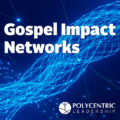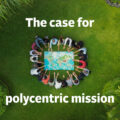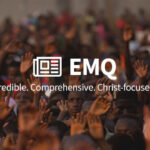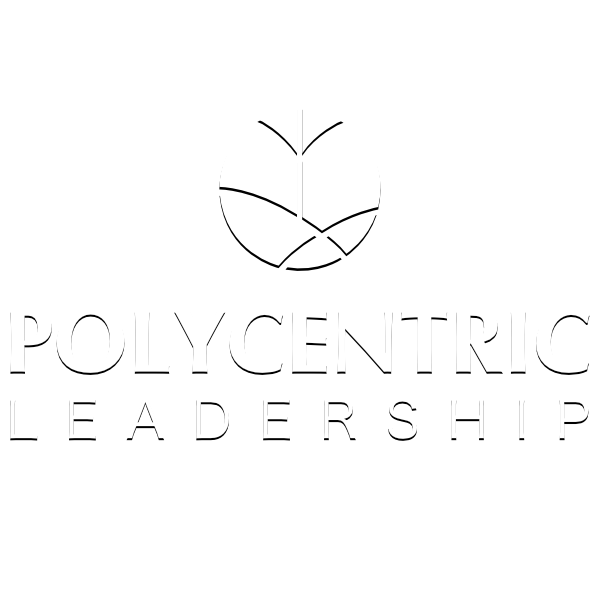SIX COMMON THEMES FOR A TRINITARIAN APPROACH TO LEADING MISSIONS
By Joseph W. Handley, Jr.
Polycentric—Why? And, what’s that?1
As the world grapples with ongoing tensions, polarities, and ever-growing challenges, I am convinced that we need a new approach to leadership. It was this concern that compelled me to study global leadership and see if another form of leadership could prove pivotal to the world in which we lead for this era of God’s mission.
Polycentrism came to my attention in reviewing the state of mission today and ways we could shift our approaches in providing godly, wise leadership as those seeking to fulfill God’s mission in the world. I first encountered the concept in reviewing Allen Yeh’s research about the 2010 centenary celebrations of the 1910 Edinburgh Mission Congress.2 Polycentrism is an approach to governance where ‘the doctrine that a plurality of independent centers of leadership, power, or ideology may exist within a single political system . . . the fact of having many centers of authority or importance.’3
During my studies, I came to believe that polycentrism provides a stronger leadership paradigm for leading missional endeavors in an interdependent, globally networked world. In reviewing recent discoveries in mission history4 and ongoing studies in governance,5 I was able to discern six important themes that comprise an emerging new theoretical leadership model which I call ‘polycentric mission leadership’.
I am convinced that a collaborative, communal approach to leadership that empowers multiple centers of influence as well as a diverse array of leaders is better suited to addressing the issues before us during this era of a globalized world, even more so now that I see the nations pulling apart from one another through tribalized reactions to the challenges we face. We need each other!
For as in one body we have many members, and the members do not all have the same function, so we, though many, are one body in Christ, and individually members one of another (Romans 12:4-5, ESV).
A Trinitarian paradigm of leadership
Foundational to this new theoretical model is the idea of how our Lord works in trinitarian fashion. Mission studies increasingly view the Trinity as a paradigm for mission. This insight has implications for the way we lead.6
Just as the Father, Son, and Holy Spirit lead in a polycentric fashion, we as mission leaders can continue in this stream by leading polycentrically. Ultimately, it is God who directs our vision and leads the way. His model is one we can emulate as we follow his lead and provide leadership in the realms that he has appointed for us to serve. As we become more polycentric in leadership, we can become more like Christ, the Good Shepherd and Servant Leader.7
Polycentric mission leadership
Leading in an era of globalization requires a broader array of voices of leaders representing local and regional constituencies who are empowered to self-organize within complex, adaptive, and self-regulating systems. Polycentric mission leadership functions across multiple spheres of influence. These can include but are not limited to geography, ethnicity, age, regions, gender, and nationalities. Ideally, it is inclusive of the various centers of influence within one’s network, movement, or organization.
Polycentric mission leadership draws from a rich diversity of wisdom to guide the movement in mission. From each of these diverse peoples and platforms, a community is formed, rooted in Christ and his tri-fold identity. This community operates in a collective fashion, inspired by the Holy Spirit, empowering and releasing the gifts and potential of everyone in the movement. This inspiration is where vision comes from. It is the work of God in our midst from which we draw strength, build roots of character, and develop core values, gaining vision for the mission of God.
Each community draws strength from their uniqueness which allows them to operate and coordinate their efforts according to their calling and vision. They form interdependent teams, working together through shared perspectives and collective processes. In essence, they are entrepreneurial networks, catalyzing self-governing entities, empowered to fulfill the mission to which they have been called.
Polycentric leadership themes
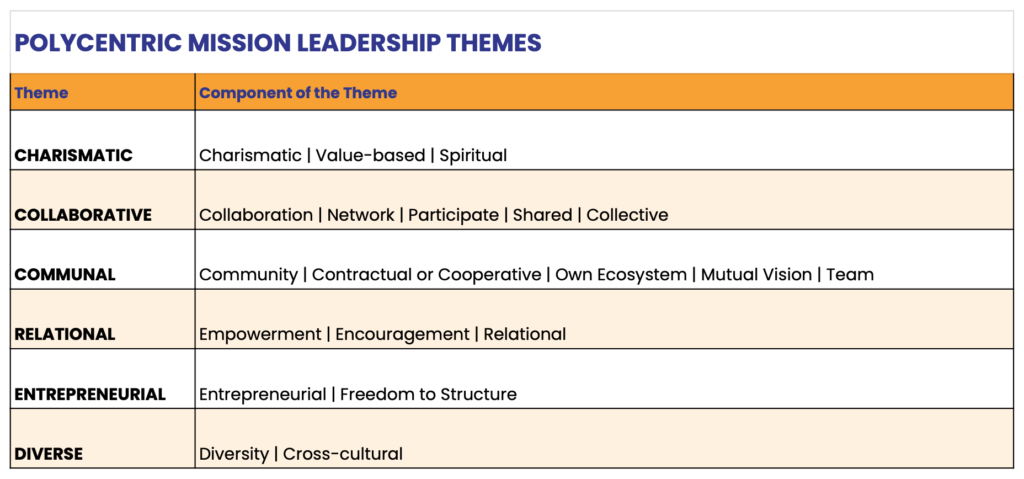
Polycentric mission leadership is composed of six common themes that, when deployed together, result in a stronger approach to leading mission movements.
 Charismatic
Charismatic
Charisma includes a strong spiritual foundation and a strong set of core values. Charisma is more than just having charismatic personality. It also involves strength of character, trustworthiness, and a faithful presence. Charisma is vital to effective polycentric leadership. Whether it be good character, spiritual inspiration, or casting and carrying out vision, charisma is vitally important to leading well as a mission leader today.
 Collaborative
Collaborative
Collaboration includes the theological collaboration around the power of the Trinity, working together in a shared participative manner. Effective leaders must be collaborative in their approach, willing to work in team-centered paradigms where no one rises above the others and all work together toward the goals of their particular network.8
 Communal
Communal
Leading through community is integral to polycentric leadership. In the fellowship and family-like atmosphere of serving together, leaders gain perspective and insight from one another and are better able to function through checks and balances, holding each other to higher standards and modeling the collective behaviors they seek to engender, fulfilling their mutual vision and mission. Collaborators become a community, establishing a contract where vision is shared so they can function as a team.
Leaders that work with others in community bring change to their various networks; they foster an environment that has the momentum to go farther together. As the teams work together, comradery builds, vision coalesces, and action begins to take shape.
 Relational
Relational
Relationship—spending time with one another, getting to know one another, and going beyond just working together—is imperative. Leading well involves a depth of relationship that goes beyond partnership or collaboration. It flows within the communal theme mentioned above but goes further pressing into deep personal ties.
 Entrepreneurial
Entrepreneurial
Self-governance and freedom are crucial for local teams to operate effectively. Entrepreneurial freedom gives rise to effective leadership. This is especially true for mission movements that thrive in a culture of risk-taking, entrepreneurship, experimentation, and innovation. Freedom means independence from overarching structures in terms of decision-making and agenda-setting. This includes teams’ freedom to structure on their own accord and around the more entrepreneurial aspects of leadership.
This type of governance does beg the question of accountability, however. Fortunately, within polycentric governance models, sharing among farmers, fisherman, and government entities all show promise. In these models, overlapping decision-making entities respect one another as they make decisions and keep the other ecosystems in mind.9 Further practical help can be found among Matrix Management systems. In these systems, leadership is sometimes rotated and seasonally assigned based on either expertise or other factors where different types of knowledge or wisdom is necessary.10
 Diverse
Diverse
Leaders who value and recognize diversity are able to work across regions, networks, and cultures. The diversity of leadership gifts described in Ephesians 4 is paramount. For diversity to be fully employed within a polycentric leadership model, it must represent every facet of diversity represented within a network, movement, or society. It is in this diversity of leadership that strong bonds develop which overcome obstacles, create unified momentum, and catalyze ideas toward a better future.
CONCLUSION
As the world becomes increasingly complex and societies become increasingly polarized, the more imperative it is for us to come together.
My prayer is not for them alone. I pray also for those who will believe in me through their message, that all of them may be one, Father, just as you are in me and I am in you. May they also be in us so that the world may believe that you have sent me. I have given them the glory that you gave me, that they may be one as we are one—I in them and you in me—so that they may be brought to complete unity. Then the world will know that you sent me and have loved them even as you have loved me (John 17:20-23, NIV).
Polycentric Mission Leadership will help us to model Jesus’ prayer: ‘that we might be one’. As we lean into these six themes, drawing from the full spectrum of our mission community, we can better embody this spirit so that the world may know Jesus as Lord and Savior!
That’s interesting . . . but now what?
Charisma
Is your life well calibrated with Jesus? Can you up your game spiritually? As you remain in Christ, ‘you will bear much fruit’; apart from Christ, ‘you can do nothing’ (John 15:5).
Collaborative
Have you adapted your leadership to a more collaborative approach? Do you include people from every sector of your network to speak into what is happening and how to move forward? We need each other, as our Lord modeled for us in his trinitarian approach (Eph. 4:11-12).
Communal
Do you seek to foster community, drawing from the rich body of Christ God has surrounded you with, walking deeply together as friends in mission? The spirit of mission is expressed best in community (Rom. 12:3-8).
Relational
Do you value, build, and nurture relationships, even as you cast vision? People are desperate for friends and mentors. Jesus led this way. He was a friend (John 15:12-17). Are you just a leader, or are you a friend?
Entrepreneurial
Key to leading mission movements today is fostering the free, entrepreneurial spirit that Jesus embodied.11 Do you foster this entrepreneurial spirit in your life and leadership?
Diverse
Do you model diversity in your leadership? There is so much talent that God has placed around you to draw from. Truly, we are better together, in Christ, as we lead in mission.I hope you will join me in this journey of mission leadership. I pray that as the Lord’s mission proceeds, we will become more polycentric or trinitarian in our approach to leading in the future!12
More Information
*This article draws from the author’s dissertation: Handley, Joseph W. 2020 “Polycentric Mission Leadership.” Ph.D. Dissertation. Fuller Theological Seminary, School of Intercultural Studies: ProQuest; 27745033.
- This article originally appeared in the May 2021 issue of the Lausanne Global Analysis and is published here with permission. To receive this free bimonthly publication from the Lausanne Movement, subscribe online at www.lausanne.org/lga.
- Cover image illustrated by Rachel Handley.
About the Author
Rev. Joseph W. Handley, Jr., Ph.D. (@jwhandley) is the president of Asian Access. Previously, he was the founding director of Azusa Pacific University’s Office of World Mission and lead mission pastor at Rolling Hills Covenant Church. He co-led one of the first multi-national high school mission congresses in Mexico City in 1996 and is a contributing blogger for the Billy Graham Center’s Gospel-Life Blog. Joe serves on the International Orality Network leadership team and on the advisory teams for the Nozomi Project, BiblicalTraining.org, and DualReach as well as the board for ReIgnite Hope. Joe strives to develop leaders for mission movements.
- https://www.asianaccess.org/senior-leaders/bio-joe-handley
- LinkedIn: https://www.linkedin.com/in/jwhandley/
- FB: https://www.facebook.com/JosephWHandleyJr
End Notes
- This paper draws from the author’s dissertation: Joseph W Handley, ‘Polycentric Mission Leadership’ (PhD diss., Fuller Theological Seminary, School of Intercultural Studies, 2020). ↑
- Allen Yeh, Polycentric Missiology: 21st Century Mission from Everyone to Everywhere (Downers Grove, IL: IVP Academic, 2016). ↑
- ‘Polycentrism’, Dictionary.com, accessed 22 June 2020, https://www.dictionary.com/browse/polycentrism. ↑
- Adrian Hermann and Klaus Koschorke, Polycentric Structures in the History of World Christianity. Polyzentrische Strukturen in der Geschichte des Weltchristentums (Germany: Harrassowitz, 2014). ↑
- Elinor Ostrom, ‘Beyond Markets and States: Polycentric Governance of Complex Economic Systems’, American Economic Review, 100 (3), June 2010: 641-72. ↑
- Jürgen Moltmann, The Church in the Power of the Spirit: A Contribution to Messianic Ecclesiology (Minnesota: Augsburg Fortress, 1993). Miroslav Volf, After Our Likeness: The Church as the Image of the Trinity (Grand Rapids: Eerdmans, 1998). Leslie Newbigin, The Open Secret: An Introduction to the Theology of Mission (Grand Rapids: Eerdmans, 1995). Roland Allen, Mission Activities Considered in Relation to the Manifestation of the Spirit (London, New York: World Dominion, 1927). David J. Bosch, Transforming Mission: paradigm shifts in theology of mission (London: Orbis, 1991). Kirk Franklin with Dave and Deborah Crough, Towards Global Missional Leadership (Oxford: Regnum, 2017). JR Woodward, Creating a Missional Culture: Equipping the Church for the Sake of the World (UK: IVP Books, 2013). ↑
- Editor’s note: See article by Mary Ho, entitled ‘The Transcendent Culture of Servant Leadership’, in March 2020 issue of Lausanne Global Analysis, https://lausanne.org/content/lga/2020-03/transcendent-culture-servant-leadership. ↑
- Editor’s note: See article by Phill Butler, entitled ‘Who Gets the Credit in Collaborative Efforts’, in July 2020 issue of Lausanne Global Analysis, https://lausanne.org/content/lga/2020-07/who-gets-the-credit-in-collaborative-efforts. ↑
- Keith Carlisle and Rebecca L. Gruby, ‘Polycentric Systems of Governance: A Theoretical Model for the Commons: Polycentric Systems of Governance in the Commons’, Policy Studies Journal, 47(2), 2017: 6-9. ↑
- Ruth Malloy, ‘Managing Effectively in a Matrix’, HBR August 10, 2012. And, Michael Bazigos and Jim Harter, ‘Revisiting the Matrix Organization’, McKinsey Quarterly, January 1, 2016. ↑
- Joseph Handley, ‘Leading Mission Movements’, EMQ 54(2), 2018. ↑
- Editor’s note: An expanded treatment of this topic, based on the original draft of this LGA article, can be found at http://www.asiamissions.net/wp-content/uploads/2021/04/AMA71_JosephHandley.pdf.





